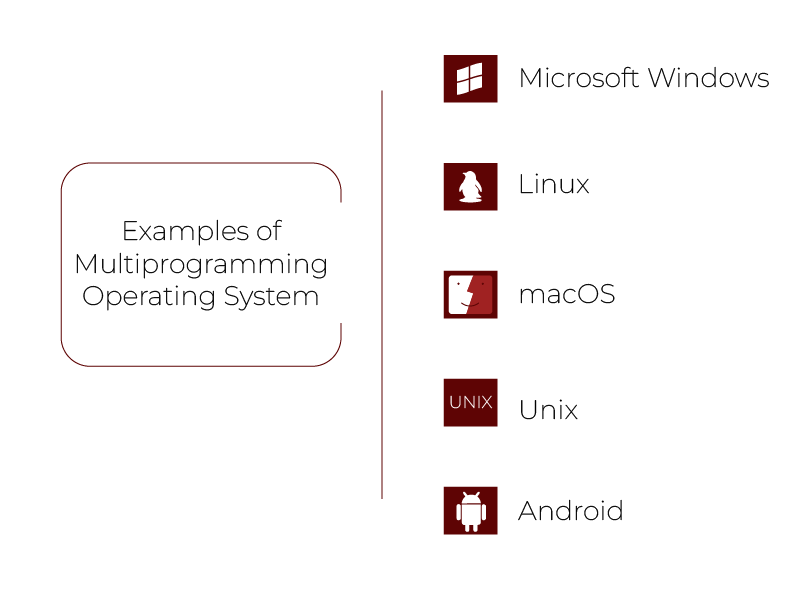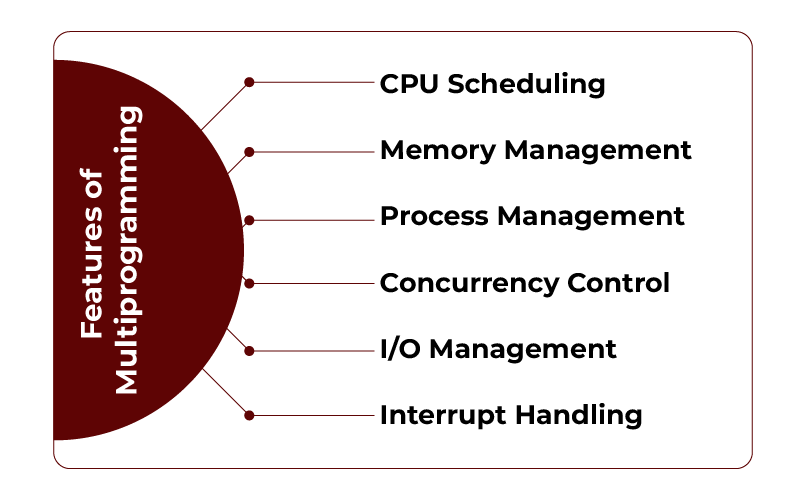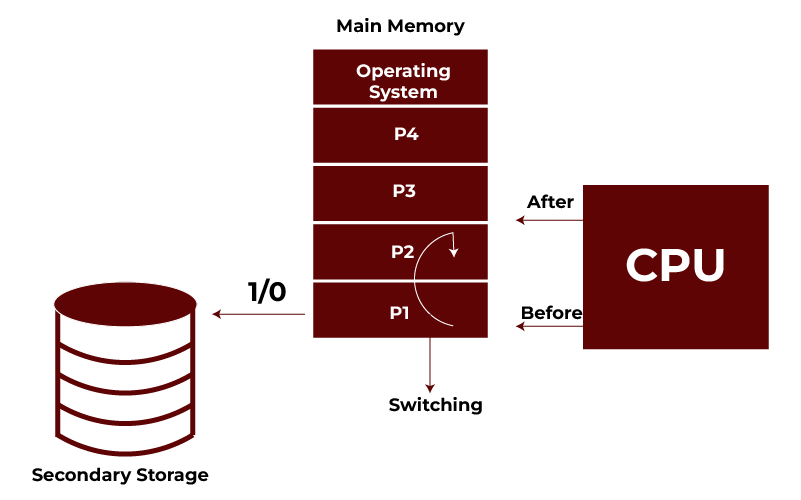A typical example of this is the multiprogramming operating system, which allows a single processor to run a number of programs at once. One program waits for I/O (input/output) operation while another program runs and the CPU switches to the second one if one or both of them are ready to run (so as not to wasteCPU time and maximize efficiency). It removes the necessity for the system to idle while this work is finished, taking up CPU time. This process currently runs until releasing the CPU voluntarily or it is blocked for an I/O operation. Multiprogramming Operating Systems are Operating Systems that are capable of many tasks in a small span of time and these are pretty much useful. In this article, we’ll find how a multiprogramming operating system works.
What is a Multiprogramming Operating System?
A multiprogramming operating system which runs several programs on a single processor computer gives the CPU time to each program in turn so that a single processor computer can run more than one program. The terms Task, Process and Job are used to describe execution of a program. Process throughput and system resource consumption are higher for concurrent program executions than for serial and batch processing systems.
Multiprogramming aims at the job of managing the system resources. A multiprogramming system has the main elements comprising the file system, command processor, transient area and I/O control system. Multiprogramming operating systems were created to store a variety of programmes according to the sub segmenting of the transient area. Resource management procedures are connected to the core operations of the operating system.
Multiprogramming is to make a system resources manageable, in the file system, memory, processors and input output device. However, in real time, the multiprogramming system permits multiple programs to be stored and run simultaneously, but not at once. To do this, the operating system takes care of routine resource management.

POSTGRADUATE PROGRAM IN
Multi Cloud Architecture & DevOps
Master cloud architecture, DevOps practices, and automation to build scalable, resilient systems.
Examples of Multiprogramming Operating Systems

Microsoft Windows
UNIX
MacOS
Linux
Android
Features of Multiprogramming operating Systems

CPU Scheduling
The overall purpose behind the operating system is to give the CPU efficient scheduling of multiple processes, or programs. It uses algorithms of round robin, shortest job first or priority scheduling to ensure fair and efficient resource use.
CPU scheduling ensures the efficient usage of resources by executing the multiple processes in CPU. To get systematic performance, algorithms such as round-robin, shortest job first or priority scheduling are based for allowing CPU time on processes in an efficient and fair way.
Memory Management
Memory allocation and deallocation for multiple processes running parallel is the responsibility of a Multiprogramming OS. The techniques used include virtual memory, paging and segmentation so as to optimize memory usage and make sure each process gets enough memory space. Within a multiprogramming OS, Memory Management controls the allocation and deallocation of memory for concurrent processes in real time.
To optimize memory usage, techniques like paging, segmentation and virtual memory are used to allow processes to access more than what they physically have access to and thus provide enough space for a process to execute. It prevents memory fragmentation allowing the whole system to run faster.
Process Management
The Tasks (Processes) are created, terminated and managed by the OS. It manages process queues, does the allocation of resources to the processes and provides for inter process communication and process synchronization. The process management deals with creating, terminating and monitoring processes.
It helps OS allocate resources to processes, maintain process queues, and provide inter process communication and synchronization. Through process management, the OS guarantees efficient resource use and coordination among the processes as well as its responsiveness and scalability.
Concurrency Control
Multiprogramming OS is such a kernel which allows several processes to execute and run in parallel without interfering among themselves. Synchronization e.g. semaphores, mutex services and certain deadlock and race condition avoidance. In a multiprogramming OS, concurrency control accounts for conflict and data corruption that would otherwise occur from multiple processes running in parallel.
Synchronization with shared resources is secured by semaphores and mutexes alike, preventing race conditions and deadlocks. The OS centrally manages the order of execution and access to critical sections of code by order processes which guarantees the unity of system stability and reliability.
I/O Management
It keeps input/output operations highly efficient to avoid clogging and make other ways to execute a stream of I/O operations comfortably. In such a setting, I/O management schemes that use techniques such as buffering, caching, and device scheduling have been developed to deal efficiently with input/output operations.
It avoids bottlenecks and frees programs to access I/O devices concurrently without interruption. The caching, buffering, and scheduling of I/O operations, together with minimizing its latency and maximizing its throughput, achieve high bandwidth. This ensures that the system can achieve multiple I/O request efficiency without degrading the overall performance.
Interrupt Handling
Hardware interrupts and software interrupts are handled efficiently by the OS to keep your execution rolling, while permitting hardware and other hardware interrupts to occur without disrupting the execution of others. In the case of multiprogramming, system responsiveness depends on efficient interrupt handling.
It allows the OS to efficiently manage hardware and software interrupts, so it runs these asynchronously to ensure that other processes are not disrupted. OS takes care to schedule and prioritize interrupts, this keeps the system running stably while allowing smooth multitasking thus producing good user experience.
Working on Multiprogramming Operating Systems

A process is a portion of memory that a multiprogramming system makes available to a single program. All of these processes and their states are handled by the operating system. The operating system selects one process being ready to the process which will be executed before the process starts executing. The chosen process may be stored in main memory while undergoing the CPU execution till there comes the time when between the processes that need some input/output operation at that time the process goes out of main memory for making I/O operation, gets stored in secondary storage and the CPU switches to the next ready process. The CPU switches to this process when the process that undergoes I/O operation comes again after finishing its work. This is happening rapidly enough, and frequently enough, such that it produces an illusion of simultaneity.

82.9%
of professionals don't believe their degree can help them get ahead at work.
Types of Multiprogramming Systems
Two known types of the Multiprogramming Systems are:
- Multiuser Operating System
- Multitasking Operating System
Multiuser Operating System
Multi user system: where more than one user employs more than one terminal and shares the processing time on some powerful central machine. Frequently switching between terminals in the operating system, each assigned to its own sector (of processor time) on some central computer, is what allows the computer to do this. As the operating system on each terminal changes so frequently, the central computer seems to have an only user, a new one every time. As a system gets more and more users, it starts to become more obvious how long the big central computer will take to respond.

Multitasking Operating System
Multitasking OSos that can run two or more programmes simultaneously. Here the operating system passes the one program at a time in or out of memory. A program must be temporarily saved on the disc whenever it is switched out of the memory, to be retrieved only when it is needed again.

Advantages of Multiprogramming Operating System
Most of the time, the processor is used and rarely becomes idle unless there are no jobs to execute.
All the jobs running in parallel amongst themselves can make this system fast.
Jobs are earlier completed for smaller CPU requirement time duration than those with larger duration.
Multiprogramming OS allows multiple users to work with the computer system.
Efficient and even resource utilization.
Processing time is reduced for the job.
A system which supports multiple jobs to be executed is called a multiprogramming OS or multiprocessor system.
Disadvantages of Multiprogramming Operating System
Sometimes processes that take long CPU time must wait for other jobs (relatively shorter jobs) to finish.
In multiprogramming, it is not easy to keep track of a large number of processes.
Schedule handling is not an easy job hence multiprogramming OS is not an easy job.
CPU scheduling is needed to multiprogram the OS.
If the memory management isn’t very efficient it’s not good.
During the program running, it is not possible for a program to interact with the user.
Difference Between Multiprogramming and Multitasking Operating Systems
| Multiprogramming | Multi-tasking |
| It is a process of loading several programs onto the computer’s memory, and allowing them to work together with the CPU. Often, the CPU switches programs, and especially when the program is waiting on I/O operations to finish. | This refers to the amount an operating system is able to execute multiple tasks or processes (or more commonly called as processes) at the sametime, switching rapidly between them. |
| Reducing idle time is the primary objective in order to raise CPU utilization. | Enhancing user responsiveness and enabling interactive computing is the main objective. |
| It does not involve direct user interaction. | Designed with human interaction in mind, enabling users to run numerous apps (such as web browsers and word processors) at once |
| Not as complicated as multitasking. What it does is it tries to keep the CPU busy running one program at a time until it has to wait on an I/O operation. | With a lot of tasks sharing user inputs, and multiple inputs that need to take place in an order, it requires more sophisticated scheduling algorithms and resource management to make sure it’s always smooth. |
| In environments where the utilization of a resource is a more critical part of a job than, say, the utilization of space on a hard drive in an HDFS cluster in circumstances where a task is long running. | In particular in desktop and mobile operating systems, it is used in interactive environments where there are multiple applications to be run concurrently. |
Conclusion
Finally, we conclude by noting that multiprogramming systems in general tend to be more efficient in terms of resource utilization, and produce higher throughput and improve user experience. They provide for concurrent process execution enabling efficient use of system resources and resulting productivity improvements. However, these increase in complexity, overhead and risk of deadlocks.
Although it has these disadvantages, the superior multiprogramming advantages outweigh those disadvantages and we see multiprogramming as a popular and common way of computing these days. Multiprogramming operating systems can be made robust by careful design, implementation, and management, to support a wide spectrum of workloads and keep up with evolving user and application needs.
What is a Multiprogramming Operating System?
But what is the difference between multiprogramming and multiprocessing?
What do we do in a multiprogramming OS?
What were some good examples of multitasking systems?
What happens under a multiuser operating system, when resources are needed by multiple users?
Updated on October 14, 2024
